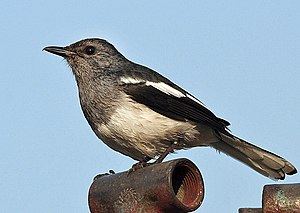까치딱새
까치딱새[2][3](Oriental magpie-robin, 학명: Copsychus saularis)는 작은 참새목 새이다. 검은색과 흰색 깃털과 땅에서 먹이를 찾을 때 똑바로 서 있는 긴 꼬리를 가지고 있다. 인도 아대륙의 대부분과 동남아시아의 몇몇 지역에서 서식하고, 숲뿐만 아니라 도시 정원에서도 흔하다. 노래로 잘 알려져 있고, 한때 사육조로 인기 있었다.
|
| |
|---|---|
 C. s. ceylonensis 수컷 | |
 C. s. saularis 암컷 | |
| 생물 분류ℹ️ | |
| 계: | 동물계 |
| 문: | 척삭동물문 |
| 강: | 조강 |
| 목: | 참새목 |
| 과: | 솔딱새과 |
| 속: | Copsychus |
| 종: | 까치딱새 |
| 학명 | |
| Copsychus saularis | |
| 린네, 1758 | |
| 보전상태 | |
|
| |
설명
편집몸길이는 꼬리를 포함하여 19cm이다. 수컷은 흰색 어깨 부위를 제외하고 윗부분과 머리, 목이 검은색이다. 암컷의 윗부분은 회색빛이 도는 검은색이고, 아랫부분은 회색빛이 도는 흰색이다. 암컷의 깃털이 수컷보다 지리적 변이가 크다.[4]
승명아종은 인도 아대륙에서 발견되고, 이 아종의 암컷이 가장 색이 연하다. 안다만 제도의 아종 andamanensis의 암컷은 색이 더 진하고, 부리가 더 무겁고, 꼬리가 더 짧다. 스리랑카의 아종 ceylonensis의 암컷은 수컷과 색이 비슷하다. 미얀마와 더 남쪽에 있는 개체군은 musicus로 명명되었다.[5] mindanensis는 현재 다른 종으로 분류된다.[6]
분포 및 서식지
편집네팔, 방글라데시, 인도, 스리랑카, 파키스탄 동부, 인도네시아 동부, 태국, 중국 남부, 말레이시아, 싱가포르에서 서식한다.[7]
한국에서는 2021년 5월 9일 전북 군산시 어청도에서 탐조인 임방연씨가 처음 관찰한 길잃은새이다.[2][3]
행동 및 생태
편집인도에서 3월부터 7월까지, 동남아시아에서 1월부터 6월까지 번식한다. 수컷은 구애하는 동안 높은 곳에서 노래를 부른다. 또한 깃털을 부풀리고, 부리를 치켜들고, 꼬리를 부채꼴로 펴고 과시한다.[8] 이들은 나무 구멍이나 벽이나 건물의 틈새에 둥지를 튼다. 4개나 5개의 알을 낳고, 알은 보통 갈색 얼룩이 있는 연한 청록색이다.[9] 암컷은 수컷보다 새끼들에게 먹이를 주는 데 더 많은 노력을 기울인다.[10]
노랫소리는 지역에 따라 다르다.[11] 다른 종의 울음소리를 모방하는 경우도 있다.[12] 암컷은 수컷이 있을 때 가끔 짧게 노래한다.[13] 노래 외에 영역의 울음소리, 출현 및 휴식의 울음소리, 위협의 울음소리, 순종의 울음소리, 구걸의 울음소리, 고통의 울음소리 등 여러 종류의 울음소리를 낸다.[14]
실태
편집싱가포르에서 1920년대에 흔했지만 1970년대에 개체수가 감소했다. 이는 외래종 인도구관조와의 경쟁,[18] 밀렵, 서식지 파괴 때문인 것으로 추정된다.
이 종에서 조류 말라리아 기생충이 분리되었다.[19] 일부 사례에서 H4N3와 H5N1 감염이 보고되었다.[20][21]
문화에서
편집각주
편집- ↑ BirdLife International. 2021. Copsychus saularis. The IUCN Red List of Threatened Species 2021: e.T103893432A183088183. https://dx.doi.org/10.2305/IUCN.UK.2021-3.RLTS.T103893432A183088183.en. Accessed on 29 July 2023.
- ↑ 가 나 박, 종길 (2022년 4월 1일). 《야생조류 필드 가이드》 개정증보판. 자연과생태. 534쪽.
- ↑ 가 나 윤순영 (2021년 5월 26일). “동남아 ‘모창 선수’ 까치딱새… 어쩌다 어청도까지 왔니?”. 《한겨레》.
- ↑ Baker, E (1924). 《The Fauna of British India, Including Ceylon and Burma. Birds》 2 2판. Taylor and Francis. 112–116쪽.
- ↑ Baker, Edward (1923). 《A hand-list of genera and species of birds of the Indian empire》. Bombay Natural History Society. 87-88쪽.
- ↑ Sheldon, Frederick; Lohman, David; Lim, Haw; Zou, Fasheng; Goodman, Steven; Prawiradilaga, Dewi; Winker, Kevin; Braile, Thomas; Moyle, Robert (2009). “Phylogeography of the magpie-robin species complex (Aves: Turdidae: Copsychus) reveals a Philippine species, an interesting isolating barrier and unusual dispersal patterns in the Indian Ocean and Southeast Asia”. 《Journal of Biogeography》 36 (6): 1070–1083. doi:10.1111/j.1365-2699.2009.02087.x.
- ↑ Rasmusen, Pamela; Anderton, John (2005). 《Birds of South Asia: The Ripley Guide. Vol.II》. Lynx Edicions. 395쪽. ISBN 978-8487334665.
- ↑ Ali, Salim; Ripley, Sidney (1988). 《Compact Handbook of the Birds of India and Pakistan》 2판. Oxford University Press. 243–247쪽. ISBN 978-0-19-562063-4.
- ↑ Hume, Allan (1890). 《The nests and eggs of Indian birds》 2판. R. H. Porter. 80–85쪽.
- ↑ Sethi, Vinaya; Bhatt, Dinesh (2007). “Provisioning of young by the Oriental Magpie-robin”. 《The Wilson Journal of Ornithology》 119 (3): 356–360. doi:10.1676/06-105.1. S2CID 86268155.
- ↑ Dunmak, Aniroot; Sitasuwan, Narit (2007). “Song Dialect of Oriental Magpie-robin (Copsychus saularis) in Northern Thailand” (PDF). 《The Natural History Journal of Chulalongkorn University》 7 (2): 145–153.
- ↑ Neelakantan, K (1954). “The secondary song of birds”. 《J. Bombay Nat. Hist. Soc.》 52 (3): 615–620.
- ↑ Kumar, Anil; Bhatt, Dinesh (2002). “Characteristics and significance of song in female Oriental Magpie-Robin, Copysychus saularis.”. 《J. Bombay Nat. Hist. Soc.》 99 (1): 54–58.
- ↑ Kumar, Anil; Bhatt, Dinesh (2001). “Characteristics and significance of calls in Oriental magpie robin”. 《Curr. Sci.》 80: 77–82.
- ↑ Sumithran, Stephen (1982). “Magpie-Robin feeding on geckos”. 《J. Bombay Nat. Hist. Soc.》 79 (1): 671.
- ↑ Kalita, Simanta (2000). “Competition for food between a Garden Lizard Calotes versicolor (Daudin) and a Magpie Robin Copsychus saularis Linn.”. 《J. Bombay Nat. Hist. Soc.》 97 (3): 431.
- ↑ Sharma, Satish (1996). “Attempts of female Magpie Robin to catch a fish”. 《J. Bombay Nat. Hist. Soc.》 93 (1): 586.
- ↑ Huong, SL; Sodhi, NS (1997). “Status of the Oriental Magpie Robin Copsychus saularis in Singapore”. 《Malay Nat. J.》 50: 347–354.
- ↑ Ogaki, Masahiro (1949). “Bird Malaria Parasites Found in Malay Peninsula”. 《Am. J. Trop. Med. Hyg.》 29 (4): 459–462. doi:10.4269/ajtmh.1949.s1-29.459.
- ↑ Alexander, Dennis (2003). “Avian Influenza in the Eastern Hemisphere 1986-1992”. 《Avian Diseases》 47: 7-19.
- ↑ 《Quarterly Epidemiology Report Jan-Mar 2006》 (PDF). Hong Kong Government. 2006.
- ↑ “Doel is the mascot”. 《The Daily Star》 (영어). 2009년 9월 16일.
- ↑ Law, Satya (1923). 《Pet birds of Bengal》. Thacker, Spink & Co. 21쪽.
